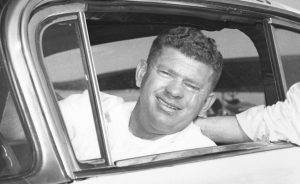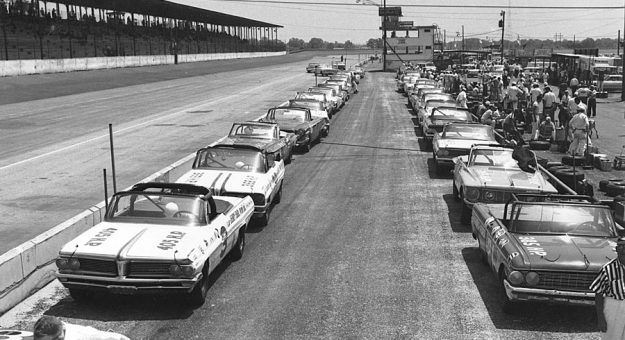Editor’s Note: NASCAR is celebrating its 75th anniversary in 2023. SPEED SPORT was founded in 1934 and was already on its way to becoming America’s Motorsports Authority when NASCAR was formed. As a result, we will bring you Part 15 of a 75-part series on the history of NASCAR as told in the pages of National Speed Sport News and SPEED SPORT Magazine.
When Curtis Turner quit the Federation of Professional Athletes and abandoned his efforts to unionize NASCAR in January of 1962, it marked the beginning of a year of reconciliation.
Two months after Turner’s decision eased any leftover inner tumult from last season, the dispute with the United States Auto Club was resolved. The March 7 issue of NSSN reported the Federation Internationale de l’Automobile-brokered agreement among NASCAR, USAC and the Sports Car Club of America, allowed their drivers to compete in each other’s races which held F1A international status.
The NASCAR-sanctioned Atlanta 500, which was scheduled for March 25, but did not run until June 10, was to be the first race held under these guidelines. At the same time, a five-year division existed between NASCAR and the Automobile Manufacturers Ass’n at the beginning of 1962, but the cracks in the auto industry’s official policy were obvious.
Reporter Harry Le Due commented on the AMA’s hypocrisy in the April 11 edition of NSSN: “The (auto industry) higher-ups decreed in 1957 that auto racing was bad public relations, risky to their cars’ reputation and much too costly to subsidize; though even today they are catering to it either by subterfuge or, outrightly, in the specifications they file with the AMA. They do this by making ‘optional equipment,’ which race drivers snatch up.”
Le Due’s observations about the auto industry’s stated versus actual involvement in NASCAR portended the United States Congress’ investigation into automobile advertising. House Commerce Committee member Paul Rogers, a Democrat from Florida, said in the April25 issue of NSSN, “There are increasing signs which show this good faith (agreement to not participate in auto racing) is being violated.”
In. June, Ford Motor Co. validated Rogers’ statement with this announcement by Henry Ford II, chairman of Ford and president of the AMA: “For a while, other member companies (abided by the agreement). As time passed, however, some car divisions, including our own, interpreted the resolution more and more freely with the result that increasing emphasis was placed on speed, horsepower and racing.”
Ford Vice President Ben D. Mills said that this was not Ford’s philosophy toward racing at a Detroit press conference in October: “The race track is a logical extension of our engineering test program.” He added, “Partly because of racing experience, today’s cars function properly and safely much longer than ever before.”
While Ford further clarified its public stance on auto racing, Bill France sought to limit the size of engines on the Grand National circuit. One week after Ford’s announcement, France imposed engine size limits on Grand National cars. Engines could not exceed 7 liters or 428 cubic inches beginning Jan. 1, 1963. Technically, the limit only affected new cars as Chrysler’s 427 c.i. engine was the largest in the division.

Glenn Roberts ‘On Fire’
The only thing Glenn “Fireball” Roberts dismantled in 1962 was speed records.
As usual, the 32-year-old Pontiac pilot drove in a limited number of events, but in the 19 Grand National races he started, Roberts set 10 track records on eight different tracks. Eight of the records, such as his 140.150 mph run at Charlotte Motor Speedway, came ln qualifying, while he emerged with the victory and the average-speed record in the Daytona 500 (152.529 mph) and in the 100-mile qualifying race for the 500 (156.999 mph).
Roberts’ third victory of the year came in the Firecracker 250, also at Daytona. He topped off the year by finishing sixth in a Ferrari Berlinetta at the 24 Hours of Le Mans in France.
Despite another spectacular year by the 32-year-old charger, another Pontiac driver rose to the top of the Grand National standings. Joe Weatherly started 52 of the 53 events and won nine times.
Perhaps even more impressive was his 39 top-five and 45 top-10 finishes. Weatherly led 17 races on the season while battling the most popular NASCAR driver and second-place point man, Richard Petty, who was close in the points for most of the season on the strength of eight victories.
Ex-biker Weatherly wrapped up his first title in the Grand National division, Eddie Crouse became the modified champ. New Englander Rene Charland won 21 races with his 1937 Chevrolet to claim the sportsman season laurels. Meanwhile, Grand National rookie-of-the-year honors fell to sportsman veteran, 26-year-old Thomas Cox.
